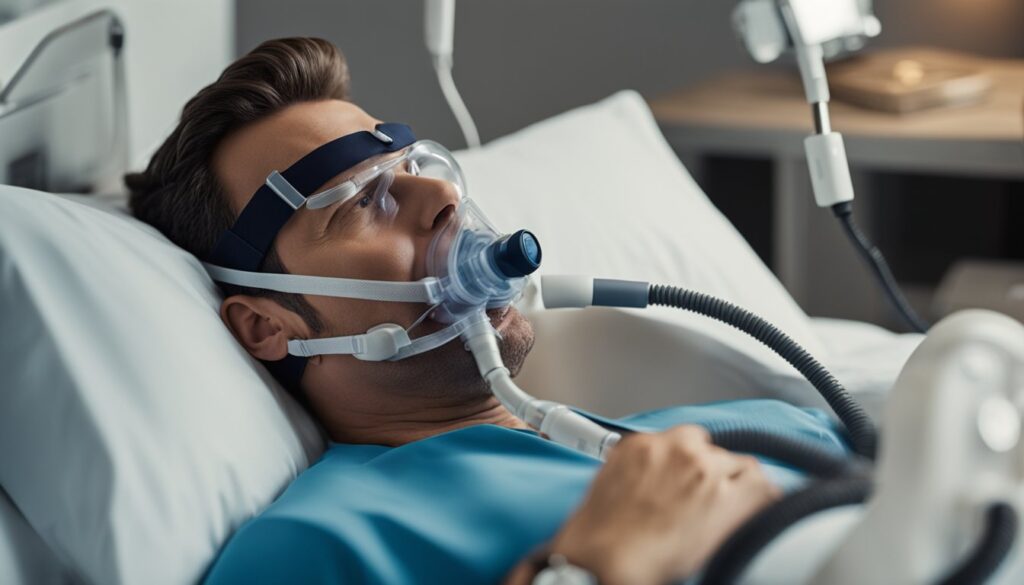Sleep apnea is a common yet serious sleep disorder where your breathing is briefly interrupted numerous times throughout the night. Each pause in breathing, known as an apnea, can last for several seconds to minutes and may occur 30 times or more an hour. If you snore loudly and feel exhausted after a full night’s sleep, these could be signs of sleep apnea.

The condition is typically chronic, disrupting your sleep three or more nights each week. Sleep apnea is notorious for its impact on your sleep quality and overall health, leading to potentially serious health complications if left untreated. Understanding the types and symptoms of sleep apnea is crucial for recognizing its presence and seeking treatment.
Having sleep apnea means that the airway becomes partially or completely obstructed during sleep, which limits oxygen flow and signals your brain to wake you up just enough to resume breathing. Living with untreated sleep apnea can increase your risk for various health issues, including high blood pressure, stroke, and heart problems. However, with proper diagnosis and treatment, you can significantly reduce such risks and improve your sleep and quality of life.
Understanding Sleep Apnea

In this section, you will learn about the nature of sleep apnea and the various factors that contribute to its development. It’s important to recognize the symptoms and understand the causes to manage the condition effectively.
Defining the Disorder
Sleep apnea is a serious breathing disorder that causes your breathing to stop and start during sleep. There are two main types: obstructive sleep apnea occurs when throat muscles relax, and central sleep apnea arises when your brain doesn’t send proper signals to the muscles controlling breathing. Symptoms commonly include loud snoring, episodes of stopped breathing, and feeling tired after a full night’s sleep.
Causes and Risk Factors
Several risk factors can increase your chances of developing sleep apnea. Being overweight (obesity) contributes significantly to obstructive sleep apnea, as fatty tissues can obstruct your airway. Other factors include having a narrow airway, which might be due to tonsils or adenoids, particularly in children. Adults over the age of 40, with a family history of sleep apnea, or who consume alcohol, smoke, or have high blood pressure (hypertension) are at increased risk. Understanding these factors can help you and your healthcare provider better address the disorder.
Sleep apnea is both treatable and manageable, especially with early diagnosis. Recognizing the risk factors such as age, obesity, family history, and lifestyle choices like smoking and alcohol use can guide you toward effective interventions.
Diagnosis and Treatment Options

Understanding how sleep apnea is diagnosed and treated can empower you to address symptoms proactively. A medical diagnosis typically involves a sleep study and physical exam, while treatments range from PAP machines to lifestyle adjustments aimed at weight loss and exercise.
Diagnosing Sleep Apnea
Your doctor may suspect sleep apnea if you exhibit symptoms such as chronic snoring or daytime sleepiness. To diagnose the condition, a sleep study is often required. This test records your brain waves, oxygen levels, and breathing patterns while you sleep. Additionally, a physical exam, focusing on your nose, throat, and neck, can provide indicators of obstructive sleep apnea.
Available Treatments
Several treatments are available depending on the severity of your sleep apnea. The most common is Continuous Positive Airway Pressure (CPAP), which keeps your airway open by providing a steady stream of air through a mask. Alternatives include different forms of positive airway pressure (PAP) devices or mouthpieces designed for mild cases. In certain instances, surgery might be recommended to remove obstructions or alter structures in the airway.
Lifestyle Changes and Management
In addition to medical interventions, your doctor may suggest lifestyle changes to help reduce symptoms and improve your condition. These recommendations could include losing weight, eating a healthy diet, and regular exercise to reduce fatty deposits around the neck area. It’s also advised to avoid alcohol and sedatives that can worsen sleep apnea, as well as quitting smoking to decrease inflammation in the airway. Adjusting how you sleep, such as not sleeping on your back, can also help alleviate symptoms.
Frequently Asked Questions

In this section, you will find straightforward answers to commonly asked questions about sleep apnea, from diagnosis to emerging treatments.
What are the diagnostic criteria for sleep apnea?
Sleep apnea is diagnosed based on the frequency of breathing interruptions during sleep. You are considered to have sleep apnea if you experience five or more events per hour. These events can be complete pauses in breathing (apneas) or periods of shallow breathing (hypopneas).
Can sleep apnea be completely cured or only managed?
For some, lifestyle changes such as weight loss and avoiding alcohol can significantly improve symptoms. However, most cases of sleep apnea are managed rather than cured, using treatments like CPAP machines or oral appliances, which maintain open airways during sleep.
What are the risks associated with untreated sleep apnea?
Untreated sleep apnea can lead to serious health risks including hypertension, stroke, heart disease, and diabetes. It can also increase the risk of work-related accidents and driving accidents due to fatigue.
How does central sleep apnea differ from other types of the condition?
Central sleep apnea is less common than obstructive sleep apnea and involves the central nervous system. In this type, your brain does not send proper signals to the muscles that control breathing, leading to periods of no breathing effort.
What specific symptoms of sleep apnea are more common in women?
Women with sleep apnea may experience symptoms such as fatigue, headaches, mood swings, depression, and insomnia rather than the more commonly known symptom of loud snoring.
Are there any new treatments for sleep apnea introduced in 2023?
As of 2023, there are ongoing developments in sleep apnea treatments, including new device designs for CPAP machines and advances in surgical options. However, for the most current and personalized treatment options, consult with a sleep specialist.